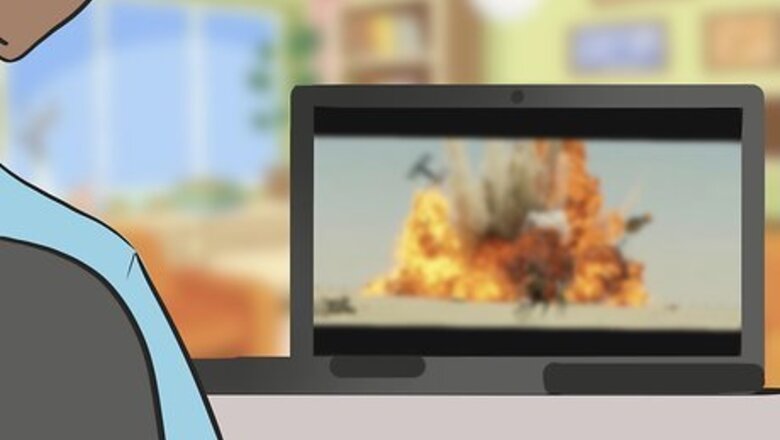
views
Spotting the Film
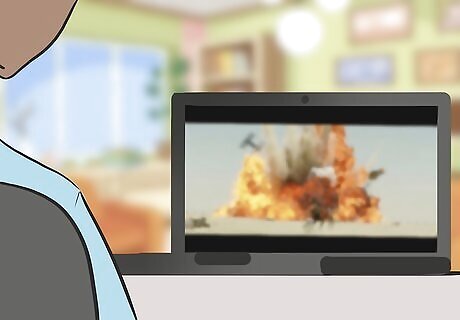
Watch the film straight through to get a feel for the plot. Start by watching the film from start to finish without taking notes or planning out the music. Just take in the plot and allow yourself to have a natural emotional reaction to it. Let the film marinate in your memory for a day or so after watching it. Every now and then, think about the way a character or scene made you feel to get your creative juices flowing.

Rewatch the film several times after your first viewing. As you watch, take notes on the film's overall tone, characters, key scenes, and scene changes. You should start to get a feel for your score's framework after at least 5 to 10 viewings. However, the right number of times depends on your creative process and the film's length and complexity. Composing a score is all about framing the film's story, so pay attention to how the plot unfolds. For instance, the story may develop in a straightforward, step-by-step manner. In some films, on the other hand, the action jumps around and the plot unfolds through flashbacks and other non-linear devices.

Note the start mark, desired effect, and end mark of each cue. When you watch the film subsequent times, note cues such as character introductions, scene changes, and dramatic moments. Write down the cue’s start time, a brief description, what feeling the music should convey, and when the cue ends. For instance, note that a chase scene starts at 24:15, its music needs to be fast-paced and exciting, and it transitions to another cue at 26:32. When the audience first meets a main character at 5:24, note that you should introduce their musical theme. You can either take detailed notes by hand or watch the film on a digital audio workstation (DAW) computer program and type in markers directly into the file while you watch.
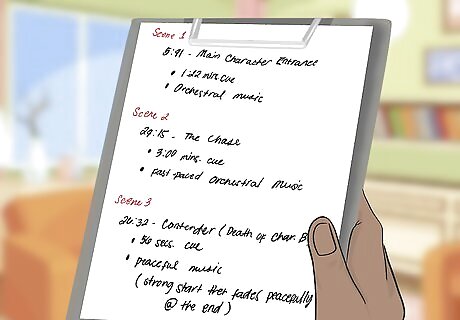
Brainstorm tempos, instruments, and other qualities for your cues. After watching the film several times, review your notes and start coming up with ideas for your cues. Determine approximately how long the cue is, then figure out a suitable tempo for the scene. Once you’ve set the tempo for a cue, hum, whistle, or play tunes on your instrument or audio program to brainstorm melodies.Tip: Choose instruments that fit the tone, theme, and context of both the film and specific scenes. For instance, a full orchestra is suitable for a climactic moment, but a simple, understated arrangement is best for more intimate scene.

Talk to the filmmaker about their goals for the score. During the spotting process, watch the film with the director at least once. Discuss their goals for specific moments and the score at large. Ask about instrumentation, styles of music, and how they imagine the score framing the story. Get the filmmaker’s input at the start of the process, and ask for feedback as you compose the score. Aim to meet their expectations, but trust your gut and keep in mind they’re hiring you for your expertise. Depending on the scale of the project, you may also meet with a music supervisor, sound editor, or other managing members of the crew.
Telling a Story with Your Score

Play with melodies on your instrument of choice. Experiment with various tunes until you find a couple that spark your interest. Then explore those tunes, and expand them into complementary melodies that you can use as the foundations for the score’s central musical elements.Tip: In general, aim to keep your melodies simple, especially during dialogue. From the film’s main theme to a character’s signature tune, simpler music is more memorable. Additionally, the score's task is to complement the film, not to draw attention away from it.

Compose a main theme that communicates the film's tone. Reflect on the film's overall feel as you play around with tunes on your instrument or music software. Create a simple, memorable tune that captures the film's mood. Then decide which instruments should present the tune to the audience at various points in the movie. Consider how some action and science fiction movies start off big and bold with the main theme played by a full orchestra. On the other hand, scores for romantic dramas, suspense films, and other more subtle genres often begin with a simple tune played by just a few instruments. Typically, the theme introduces the film in the opening credits and recurs throughout the story. The right instrumental choices depend on the tone of a specific scene. For instance, a woodwind soloist may play the theme throughout most of the film. Then, in the most climactic scene, it recurs with a full orchestra and choir. If you have trouble coming up with a tune, listen to themes of films that are similar to the one you're scoring. Try imagining that you're the main character, and channel their emotions as you hum or play around with tunes on your instrument.
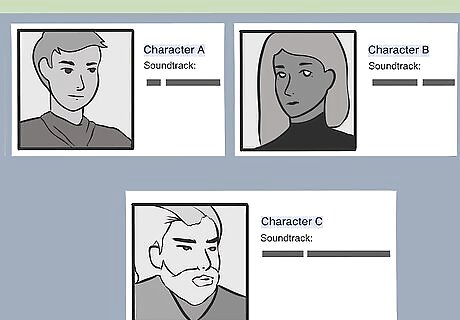
Come up with themes for main characters and key plot events. Main characters typically have a signature theme that accompanies moments where they’re central to the action. Use these themes to convey a character’s traits, foreshadow their development, and hint at how they contribute to the plot. For instance, if a character will ultimately become a villain, a deep, slow, and foreboding melody in a minor key can foreshadow at their eventual demise. A good theme for the protagonist, on the other hand, is bold, uptempo, and is built on major chords.

Look for opportunities to reprise themes throughout the film. A good film composer is economical. Once you have your core themes, vary them to fit specific moments in the plot. Change keys, switch up instrumentation choices, and slow or quicken tempos so a theme fits the plot at specific points in the film. For instance, during a chase scene or battle, you could increase the main theme’s tempo, raise its key, and double down on orchestration. When a film’s lead characters share a quiet, intimate moment, you could slow the score’s romantic theme to convey gravitas. When they’re ripped from each other’s arms, you can convey passion by recurring their theme with full orchestration.

Use sudden silence in moderation to bring focus to a scene. While the score’s task is to bring focus, absence of music is sometimes the best way to frame a scene. Here and there, pause dramatically to enhance an important act or piece of dialogue. Tense, fast-paced music could build up the suspense prior to the dramatic pause. Then the music could cut out when, for example, one lover confesses their feelings for the other.
Completing Your Composition
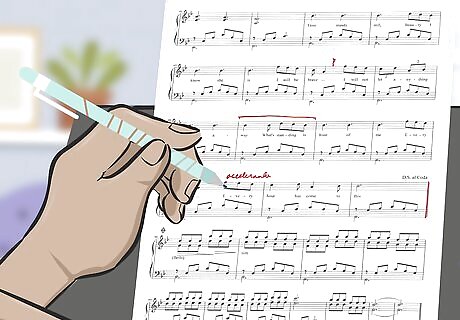
Arrange your score in musical notation. Notate your composition as you compose each section of your score. If you’re skilled at writing sheet music, you can do it by hand. Alternatively, use a DAW program to play your melodies and automatically generate basic sheet music. You can then hire someone to polish your arrangement's notation. Your score needs to be in notation if you'll be recording musicians playing it. Additionally, film scores are often published so other musicians and music students can play the songs on their own.Tip: Mark your sheet music with specific, detailed notations, especially if you’ll be recording musicians instead of using a synthesizer. Instructions on accents, volume, and tone are important, as notes and chords alone won’t necessarily translate the effects you want your music to achieve.
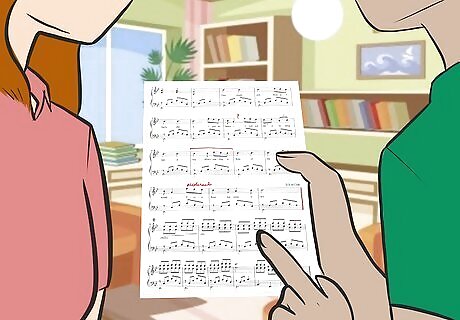
Check in with the filmmaker about key themes and markers. The filmmaker and crew probably won’t need to hear every second of background music before the final recording. However, you’ll need to run core themes and music that accompanies pivotal scenes by them. Either arrange for them to visit your studio or send audio files of rough recordings if you need to work remotely. Try not to get down on yourself if they’re not on board with one of your choices. Explain your ideas clearly and try to work with them to strike a balance between your respective visions for the film and score.
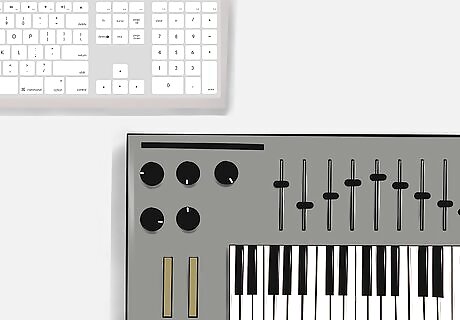
Record the score on a DAW program. Record your soundtrack using an audio program and the highest quality microphones possible. Assemble your musicians and vocalists in a studio, if you’re using live players. Alternatively, use a synthesizer and record your score directly through the DAW. Digitally recording your score will enable you to refine the tracks, easily send them to the sound editor or filmmaker or, if you’re making your own film, sync the score with the film. Generally, film scores aren’t re-recorded and are used as is. Because of this, it’s important to use high-quality microphones and set up the best possible studio conditions.

Edit your tracks using your DAW. Play back your recorded tracks and remove any echoes and accidentally recorded sounds. DAWs typically have helpful tools that automatically clean up tracks. Additionally, adjust your tracks' volumes so instruments and any vocals blend with each other. You can also hire a sound editor to mix your tracks if you don't have experience with mastering audio recordings.
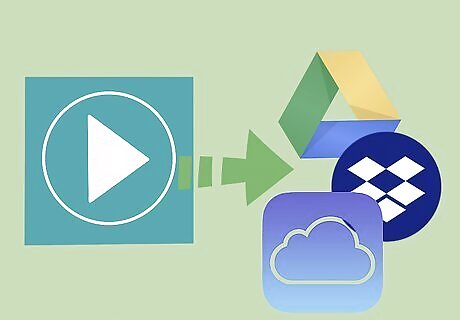
Deliver your score to the film's director or sound supervisor. Check with the director or music supervisor about their preferred delivery method. Typically, scores are sent as digital files rather than as CDs or other hard storage devices. You'll upload the digital file onto a website that zips large amounts of data and enter the director or supervisor's email address. The website will then send a link to the director or supervisor so they can download the score. If necessary, work with your point of contact at the film to make any tweaks they request.




















Comments
0 comment